Plaveč Castle
The neighboring village exists from 12th century. It was a settlement of Polovec guards (tribe from western steppe). Plave Castle is mentioned in writting in 1287. It was a center of Plaveč Castle estate served as sentry post on the border with Poland. There are now ruins of the gothic castle, built at the end of the 13th century. First written note on the castle is dated 1294. Its owners changed frequently. In 1450-1458, it was the seat of Captain Peter Aksamit. His warriors came from West. The Castle burned down in 1856 and was abandoned. It's aspectacular view towering above the Poprad River.
Mr. Peter Ambrovic, Amb. of the Embassy of the Slovak Republic at Jakarta
The History of Plaveč
Village Facts
Varying names of the village over time: 1287 Palowcha, 1289 Paluch, 1322 Plaucha, 1773 Plawecz, 1786 Plawec, 1920 Plaveč, 1927 Plaveč nad Popradom (Poprad is the river so it is Plaveč above the river Poprad), 1948 Plaveč. In Hungarian it was called Palocsa.
Šariš County; district Sabinov, region Prešov until 1960; from 1968 district Stará Lubovna, Eastern Slovakia Region.
Other parts that belong to the village are Pastovník, Podzámok, and Závoda.
Population in years: 1869-1,325, 1880-1,487, 1890-1,396, 1900-1,332, 1910-1,177, 1921-1,071, 1930-1,235, 1940-1,499, 1948-1,441, 1961-1,570, 1970-1,773.
Size: 1790 HA is the size of the village. HA is short for Hektar. 1 Hektar is 2.471 acres.
Background
The center of the village is 488 meters above the sea level. The range of the surrounding area of the village is between 482 and 694 meters above the sea level. Plaveč lies in the valley of the river Poprad at the connection of Lubovna and Levocas mountains. There is a mineral spring with a high amount of iron in it within this area. On the western side is a forest. The soils are mostly brown.
There was a settlement here in paleolite era. The village began as a settlement of watch soldiers that used to be at the crossing to Poland in 12th century. The village is first mentioned in 1287 as belonging to and being a center of the nobleman of Plaveč which also owned the following villages: Andrejovka, Bajerovka, Circ, Durková, Hajtovka, Hromoš, Malý Lipník, Matysová, Obrocné, Orlov, Plavnica, Ruská Vola, Starina and Údol. The castle Plaveč was built in 1294 as a border fortress. The owners changed often. In 1449 BRATRICI-Hussites gained control of the castle and it became the main post of the leader of BRATRICK’S Peter ASKAMIT. In 1456 and 1631 the serfs of the castle fought against the castle rulers due to the oppressive conditions that they lived under. The castle was rebuilt into a nobleman residence. In 1856 it burned and was deserted. In 1355 they had a toll station in the village. In the 14th century the village belonged to the family BEBECK. From the 15th century a serf town was developing with important markets. In 1505 it was granted the market rights. The coat of arms had a man with a sword. In the 18th century the landlords were of the family name Horvath. In the 19th century the Salamon family had large holdings there. In 1756 the town had a fire and was destroyed. In 1787 there were 64 houses and 766 inhabitants. In 1828 there were 130 houses and 958 inhabitants. At the beginning of the 20th century they incorporated a factory to produce cheese and opened a quarry. After 1918 most of the inhabitants became farmers. During WWII in 1945, 70% of the village was burned to the ground. In 1948 there was a devastating flood.
The ruins of the castle are from the 13th century and there are building ruins from the half of the 14th century. Renaissance building ruins of the manor houses from the 16th century and from the 17th century are also still seen. These ruins were destroyed by fire in 1856.
The church originally Roman Catholic, Gothic style, was enlarged by a renaissance chapel. In 1730 it was remodeled in Baroque style. Inside the church there is a monstrance from the gothic period and a late gothic statute of Madonna and three table paintings from the 16th century ( which were moved to Saris museum in Bardejov). In the settlement called Durkov there is a Greek Catholic Church from the second half of the 16th century which was rebuilt after 1726. In 1810 it became grain storage building and in 1815 it was remodeled for use as a church again.
Restorers uncover underground secrets of Plaveč Castle
Reprinted here with Permission of
The Slovak Spectator
The castle continues its transformation.
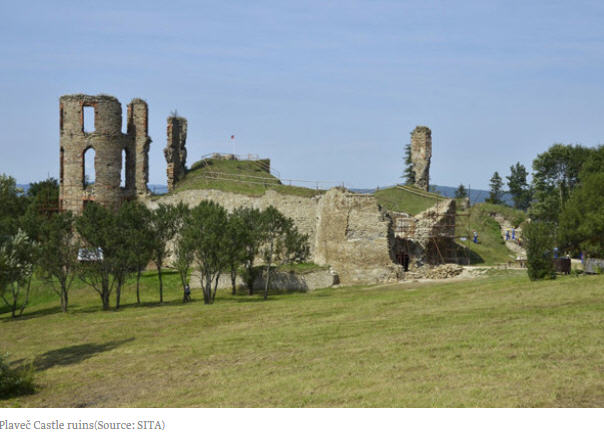
The ruins of Plaveč Castle in the Prešov Region, whose reconstruction started four years ago, is gradually changing its image. “Until now, it was known for its four-storey tower, but now we’ve completed the construction of two big defence towers, which are bigger in size in the ground plan than the first one,” said Martin Sárossy, the reconstruction’s coordinator, as quoted by the SITA newswire.
The towers were situated more under the ground than above. They managed to uncover and reconstruct them, he added.
The castle becoming gradually accessible
The restorers continue in uncovering the castle’s underground.
“We’re gradually making the underground floor of the southeastern bastions accessible, with preserved embrasures and the original floor,” Sárossy said, as quoted by SITA.
The original height of the room where the floor is located remains a mystery. Currently, it is 1.5 metres high.
Thanks to the previous reconstruction work, the castle interiors opened to the public for the first time during the summer. Visitors could see historic images and castle models, SITA reported.
The castle is already among one of the best accessible in eastern Slovakia. It is possible to park one's car very close to the castle gate. It is situated close to the castle route that connects Stará Ľubovňa Castle with Muszyna in Poland and Kamenický Castle near Sabinov.
The unemployed helped with reconstruction
Plaveč Castle passed into ruins nearly 150 years ago. The current reconstruction project is also financed by the Culture Ministry, and is offering job to the unemployed. Last year, 20 unemployed people were working there.
“I hope the castle’s reconstruction will continue since the Culture Ministry has confirmed the programme for hiring the unemployed will continue for another three years,” Sárossy said, as quoted by SITA.
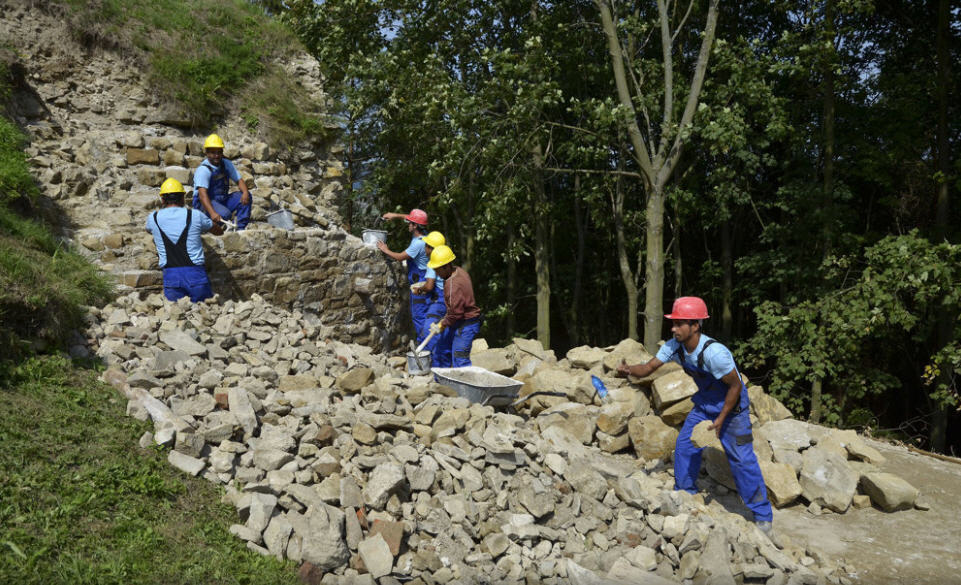
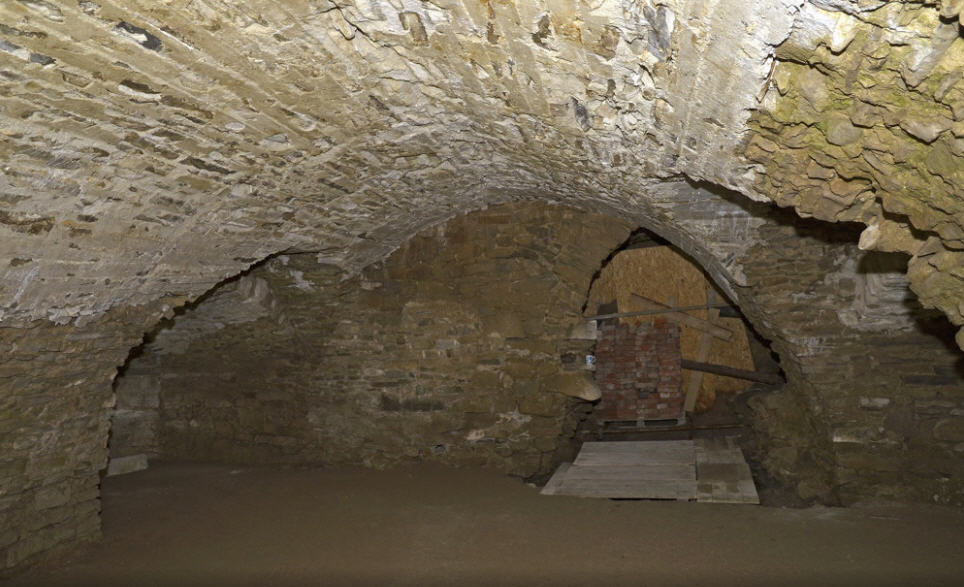
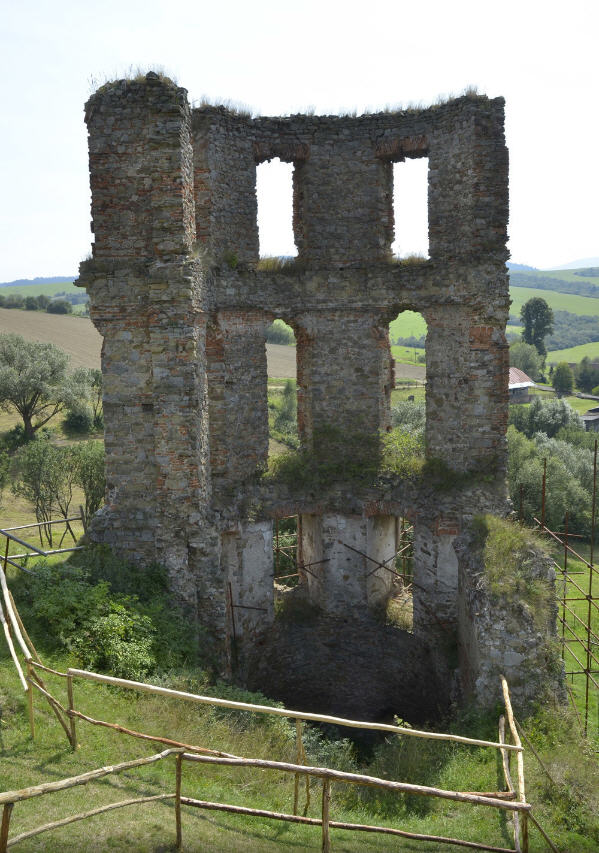
| Compiled by Spectator staff
Prešov
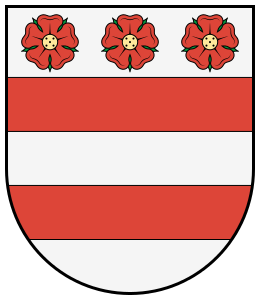
The City of Prešov has a centuries old history. Archeologists have found evidence of settlements which date back to the 8th century. During the period of 1241, King Bela IV of Hungary requested German settlers relocate to the city. Prešov became a German speaking settlement along with others in the future who were Slovak, Ruthenian, Hungarian, Polish, Jewish and Ukrainian. In 1412 the city created the Pentapolitana which was a trading group of five towns. After 1526, the city changed hands numerous times. It was the influx of trade with present day Poland that would expand the economic fortune of Prešov. Some of the first books on Tokaj wine were written in Prešov and in 1572, salt mining began near the city. There were also many upheavals such as the Protestant Reformation. During 1604-1606 it was the front line of many religious based conflicts. In 1647 the Hapsburg Empire declared Prešov the capital city of Sáros district and in 1687, Imre Thokoly, a Protestant Hungarian rebel, was defeated by the Hapsburg army known as the Battle of Eperjes.
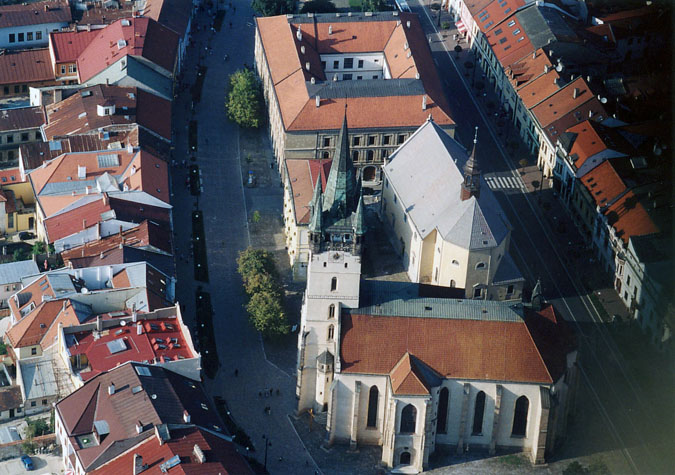
The city endured further hardship during the 18th century. Outbreaks of Bubonic plague and many fires reduced the population. Later, the city rebounded in population and economically. New factories were constructed, trade expanded and even though the salt mine became flooded, it was still operational by boiling salt brine. A British author, John Paget, visited Prešov and was so impressed he described it in great detail in his book “Hungary and Transylvania” published in 1839. A horse breeding farm was constructed in 1859 on Sabinovska Street. These horses were of such excellent quality they were purchased by various individuals throughout the Austro-Hungarian Empire. During this period the industrial revolution touched all areas of society. The first railway was constructed in 1870. The railroad connected the city with Kosice and later, other towns and cities. Telegraph, telephone, electricity and an entire sewage system were installed which added to the city’s growth.
Prešov continued to expand and today it is 27 miles in size. After World War I with the Treaty of Trianon, the city became part of the newly created Czechoslovakia. Many institutions relocated from Kosice to Prešov including the Slovak Theatre. Prior to World War II the city counted a Jewish population of over 5,000 inhabitants and included five synagogues. The Nazi regime executed and deported the existing Jewish population to the death camps and today, the city only counts approximately 100 Jewish residents. A memorial is located outside the last surviving synagogue which is located off the main square in memory of those who perished in the Holocaust.
Two of the most important Catholic churches in Prešov are Saint John the Baptist Greek Catholic Cathedral and Saint Nicholas Roman Catholic Co-Cathedral. There are many historical buildings with the most valuable being the Rakozci Palace. The most historic square area is the Greek Catholic Cathedral of Saint John the Baptist. This area forms a connected structure with the Bishop’s Palace and the Greek Catholic Theological Seminary. Two popular museums compliment this square which are the Vlastivedne Museum and the Museum of Wines. A state regional archives is also located in Prešov. Vital Statistic, Military and various Census records are kept at this archive. As the third largest city in Slovakia and the seat of regional government in Eastern Slovakia, the city is a bridge between the past and the present. The current population is over 100,000 people and many still reside in communist era block apartment buildings. City planners have implemented many revitalization projects to change these inferior structures. Numerous businesses are located in and near Prešov such as the Saris brewery, mineral springs and an opal mine. Prešov is also a sister city to numerous other cities in Europe. In the United States, it is a sister city to the City of Pittsburgh, Pennsylvania.
Entryway to Slovak Paradise National Park
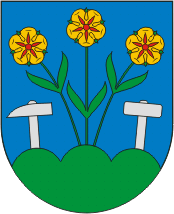
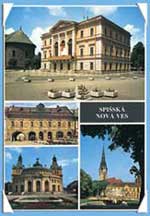 Spisska Nova Ves is an interesting town that is rich in history and culture. The reason for the expansion of this important Slovak town was probably due to its location. Situated near a major trade route that connected Hungary with Krakow, Poland and being close to the mining town Roznava, Spisska Nova Ves grew rapidly. Originally, the town was named Villa Nova (New Village) as was mentioned in a document "plebanus de Villa Nova dated 1268. Research has concluded that this area was originally settled during the 8th to 9th centuries. During Hungarian administration Spisska Nova Ves also had another name. The term Igló was used to identify the town and the district name was Szepes.
Spisska Nova Ves is an interesting town that is rich in history and culture. The reason for the expansion of this important Slovak town was probably due to its location. Situated near a major trade route that connected Hungary with Krakow, Poland and being close to the mining town Roznava, Spisska Nova Ves grew rapidly. Originally, the town was named Villa Nova (New Village) as was mentioned in a document "plebanus de Villa Nova dated 1268. Research has concluded that this area was originally settled during the 8th to 9th centuries. During Hungarian administration Spisska Nova Ves also had another name. The term Igló was used to identify the town and the district name was Szepes.
Due to its location, the town became a very important trade and governmental center. The Roman Catholic Church of the Assumption of the Virgin Mary was constructed around 1268. Outside the wall of the church trade was conducted. Butcher stalls, workshops and numerous professions all conducted business along these walls. As for the church and its surrounding property, it was not only utilized as a house of worship. The church property was also used as a tactical advantage. The cemetery was located on the south and east sides of the church. In times of conflict and during attacks upon the town these properties were utilized as a last resort battlefield.
The major economic industry in this area of the Spis region was mining. Within the Spisska Nova Ves region there were numerous mines, foundries and smelting furnaces. The most significant bell foundry in Slovakia is connected with the name of Spisska Nova Ves as its master, Kondrad Gaal, resided there. Showing the importance of the town, in 1380 King Luis I granted Spisska Nova Ves permission to hold weekly markets. Along with this Royal Order, permission was extended for trade and marketing which aided Spisska Nova Ves to become a major center of commerce and trade. There were other orders granted and in 1408, King Sigmund extended rights for weekly markets and, for holding an annual market on August 15th (Feast of the Assumption of the Holy Virgin Mary who was patroness of Spisska Nova Ves) each year. Unfortunately, being a royal town could be problematic. In 1412 King Sigmund pawned Spisska Nova Ves and several other Spis towns to Polish kings. For a full 360 years, Spisska Nova Ves was under this control. Not only in commerce but also in education Spisska Nova Ves excelled. During the first half of the 14th century a school was constructed that was overseen by various religious orders. The number of guilds organized in Spisska Nova Ves attested to the commerce of the town. There were blacksmiths, wheelwrights, weavers, basket-makers, bakers, furriers, millers and coppersmiths.
During the Middle Ages, a high percentage of the towns’ population was of German origin. Due to these ties with Germany, it is not surprising ideas were exchanged and, a new theology (Martin Luther) was brought to Spisska Nova Ves. The period of the reformation was difficult. In 1569, any forms of Catholic services were forbidden. It was not until 1674 that Spisska Nova Ves would see its church returned to the Catholic population. In 1694 Evangelicals (Lutherans) built a wooden church in the main square area. After time, a new Evangelical church was built in the park of the main square. This church, built in 1796, still stands today.
The present town hall building was constructed during the period of 1777-1779. As years progressed, stoneware and pottery production flourished. The well known stamp of "Iglo" was well known and produced some of the finest dinner ware, plates, cups, candlesticks and various other household items. This factory was in continuous operation until 1869. Expansion for the town was always favored and during the period of 1870-1871 construction of the Kosice-Bohumin Railway was finished. During 1862 a connecting railway line to Levoca was added and this helped businesses and industries to increase at a very fast pace. In 1894 a power station was built in Spisska Nova Ves but growth of its industrial base slowed due to the outbreak of the First World War in 1914. History is well preserved in Spisska Nova Ves today. Many buildings have been remodeled and the square area is a delight. Walking at a leisurely pace, there are many shops to explore. After an afternoon of shopping, a visit to one of the numerous sweet shops should not be missed. One sweet shop the author recalls is right across from the church/town park area and offers delicious homemade cakes and the best Vienna coffee. As the day closes, resting at one of the tables with a homemade cake and Vienna coffee is the perfect conclusion to a day at the square. The town offers many items that are interesting for visitors. The Museum of the Spis Region in Spisska Nova Ves was begun in 1951. It is located in the Provincial House that is a historical building. Having served as a town hall in prior years, in 1774 it was the seat of the 16 Spis Towns province. It is one of the most prized historical buildings in the town and well worth visiting. For those who enjoy art, a stunning exhibit is offered at the Spis Artist's Gallery. The paintings and sculptures in this gallery are amazing. One painting, which is on prominent display, is of a husband and his wife. This painting is so lifelike you are drawn to it immediately. The Gallery’s main focus is for artists of the Spis region but there are works on display from artists who resided in Spisska Nova Ves. The Gallery itself is located within a renaissance-based building and is a jewel of architecture.
The wealth of architectural styles found in Spisska Nova Ves is astounding. Renaissance, Gothic, Baroque or Neo-Classical, all are visually pleasing and very interesting. There are many concerts held at the Concert hall of the Reduta building. This building, painted in light shades of crème and tan, is just as beautiful outside as the interior and music are inside. The Town Theater is also a work of art and many performances by the Spis Theater Company are held here. Built in a circular fashion, it is graced by two small towers and the middle circular dome is topped with a golden bird. Spisska Nova Ves even offers visitors a basic zoo that is a delight for children. The town population which is approximately 50,000 sounds high but the square area is mapped out in such an intelligent way crowding never seems to be a problem.
The annual Spis market held during the summer months is fabulous. Various vendors sell their merchandise and there are many items such as folk crafts, clothing, flowers and just about anything one would want to purchase. With a town filled with such history, architecture and art, it is no wonder Slovaks are so proud of their town. The surrounding areas also hold interesting sites. The Slovak Paradise National Park and Spis Castle (the biggest castle in Slovakia) are all within driving distance of the town. There are also many hotels and pensions in this region with one, the Hotel Metropol being in Spisska Nova Ves. This modern hotel is the perfect base of operations for a most enjoyable visit to a fascinating town in Slovakia.
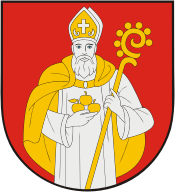
Pride of the Northern Spis Region
By Michaela Melounová & Zuzana Habšudová
Slovak Spectator staff
Photos Courtesy of Steven M. Osifchin
Photos Courtesy of Steven M. Osifchin
1948 - 2008
Eternal Memory - Vechnaya Pamyat
Pride of the Northern Spis Region
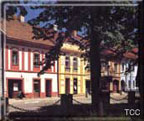

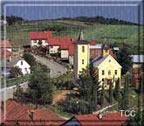
Hidden behind the High Tatras is the Northern Spis region. This area, close to the Polish boarder, is part of the Carpathian arch. In Roman times, it was considered an important strategic position for this far limit of the Empire. The Poprad river runs gracefully through this area and the town lies in a low valley. This river became an important trade route and towns were constructed due to this. There is no exact data to pinpoint the beginning date of Stará Ľubovňa. The town existed as early as the 11th century but some historical scholars claim the town was in operation as early as the year 1000. According to some historians, it is possible that Podolinec, Hniezdne, Lubovna and Lubotin were in existence as early as the Great Moravian period. Two coins were minted by Belo III (1172-1196) and offer possible evidence about the town. In reference to certified data, Stará Ľubovňa is mentioned in an important document of Wenceslas II, King of Bohemia and Voivode of Poland from 1292. This document offers information in reference to privileges the king offered to Henrik, a knight from Podolinec. Lubovna is mentioned in this document as a village. A document from 1292 offers the dependence of Lubovna upon Podolinec, but during the 14th century this would change. In 1308 Nova Lubovna was started and from this point onwards, Lubovna was referred to as Stará Ľubovňa. Historical data shows that Stará Ľubovňa was granted privileges and rights the same which were granted to towns such as Kosice. The year 1412 was an important date in the history of Stará Ľubovňa. During this time, the pledge of 16 towns of the Spis region was offered to the King of Poland. During 1431 to 1433 the Hussites invaded the Spis region and burned down monasteries and entire towns. The town saw many periods of upheaval and social unrest. Due to the towns connections with Poland, there also were many benefits received. Famous Italian architects and scholars came to this town and it expanded rapidly. Services flourished and a large number of guilds were established such as weavers, shoemakers, bootmakers, tailors, butchers and skilled furriers. Trade flourished in the region and weekly and annual markets were founded. Within the realm of Stará Ľubovňa there were other municipalities such as Podsadek, Josephi Villa and Francisci Villa. In modern times, Podsadek has become part of the town of Stará Ľubovňa.
Stará Ľubovňa is a modern town but still excludes charm from past centuries. The combination of cultures and religions gives the town a unique character. The medieval square which is dominated by St. Nicholas Roman Catholic church is exquisite. The square is encircled by buildings which are mainly shops, government offices, restaurants, foreign exchange offices and other businesses. Saint Nicholas church is not to be missed. It is a beautiful edifice which graces the square and was originally begun in the 14th century. Its soft yellow color blends perfectly with the colors of surrounding buildings. It is said, although not confirmed, that this church was built by Nicolaus Comes, the heir of Lubovna at that time. The strongest evidence found in the records is a date of 1280 where the church is mentioned. This date is generally agreed upon by many historians as a date when the church was fully operational. In the 17th century the church was rebuilt and remodeled. It was changed from its original single nave Gothic style to a three-nave style. A tower was added at the western side of the church and is a visual delight. Some of the historical monuments in the church are striking. St. Nicholas’ altar is of the Baroque style from the second half of the 18th century. In the center is an oil painting of Saint Nicholas. Sculptures of Saint Stephen and Saint Lawrence can be found on the side. Sculptures of Saint Augustine and Saint Gregory are found above the arch doorway. The altar is decorated with rich ornamentation. This period saw the rise of the Protestant faith in the Spis regions and much conflict ensued. The church and her members expended great sums to adorn their churches to support Roman Catholic beliefs. A sculptor of Christ upon the door of the tabernacle on the altar is a masterpiece.
Entering the interior of this church, the grandeur of faith is seen. Many of the side altars are works of art being made of wood, yet covered with gold leaf which give them a living feeling. The church interior is of light yellow, white and light gold which reflect the golden hues on the side altars, statues and altar. Not to be overlooked is the hand made tapestries which grace the side altars. Upon close inspection an individual can see the thousands of threads that were needed to complete the tapestry. If an individual moves back the entire tapestry looks as if it were a beautiful oil painting. Another work of art in this church is the Madonna of Lubvovna. This statue, even though centuries old, has realistic eyes and features. Carved from wood, the statue when viewed seems to be animated. The Virgin holds an infant Christ in her left hand while in her right she holds a scepter. Two angels grace the pedestal of the statue and the scroll work is magnificent. After leaving this church and strolling the ever busy square, a visit to the market is always interesting. The market has functioned for centuries and during certain days, the market comes to life. All types of items are sold from the town and surrounding villages. Fresh vegetables, fruits, meat, clothing, farm equipment, and even livestock are sold here depending upon the season. This marketplace is truly the "soul" of Stará Ľubovňa. Many types of people come to buy, sell or just observe the process. This market is a common meeting place for residents from the outlying villages and is considered a type of social activity by many. The market generally opens very early in the morning and by mid-afternoon, it is already winding down for the day. Exploration of the various shops in the square area is never disappointing. Many items can be found along with excellent crystal products. The clothing stores are always full and offer many western imports and modern styles. Many of these stores can be located through the various "tunnels" which connect the medieval buildings in the square. You have to explore each one as few signs are posted on the buildings but this is great fun to do.
Walking back through the square, many buildings can be seen which are visually pleasing and historical treasures. An item of interest is the fountain near St. Nicholas tower. This fountain has a unique stone sculpture located in the middle of the circle and is graceful. One of the most important buildings is house number 12, the former residence of the governor of the towns of the Spis region. It was built in Renaissance style and dates from the year 1639. Recent modifications and remodeling have been executed to restore this building to its original beauty. Other houses to be seen are house number 1, built in the later half of the 18th century and not to be missed is the small statue of the Virgin in a small indentation between the second and third windows. House number 21 offers a painting of the Holy Trinity and was built in the 18th century. House number 23 is fascinating due to its architecture and wood work. Built in 1813, this date is carved into the building along with an emblem, two lions and a pelican. There are many fine restaurants in Stará Ľubovna which can be found on foot, or via car. An excellent one is the wooden "Salas Polana." Located on the outer regions of the town, this fine restaurant offers outstanding Slovak cuisine. The wines offered at this restaurant are of the finest quality and their menu is so diverse a choice becomes difficult. There are private rooms for dining and the author has enjoyed the pleasure of experiencing this. The interior is that of a rustic lodge and very appealing. The service is excellent and always courteous. Another good restaurant is located in the "Druzba" This restaurant, while not modernized as the Salas Polana, offers excellent Slovak food in a very low key atmosphere. The food is excellent and the staff very willing to accommodate any request. Again, there is a public section to dine and also a room for private dinners which is very cozy. These restaurants do tend to close early if customers are limited so it is best to get there during the late afternoon. Hotels are being renovated and expanded due to the increasing numbers of tourists. Two at present are Hotel Vrchovina Tatry and the Hotel Lubovna. To see history, a visit to the Lubovna Castle is necessary. This castle today is a museum and has overlooked the town for centuries. Below the castle is a stunning open air museum of folk architecture which includes wooden homes from various villages. Also included is an original wooden church which was offered to the museum by the village of Matysova. The wooden homes and churches are open for review and are decorated according to their respective time periods. The church interior is small, yet captivating. The icons which grace the iconstanis are original paintings. A climb to the choir loft offers an excellent view of the wooden architecture of this church.
Castle tours are given during the summer but the author was honored to experience a special tour when the castle was closed for the season. The interior is magnificent and walking along the winding walkways and tunnels are intriguing. When leaving the interior parts of this castle, make sure to sign the guest book. Names in this book represent many countries in Europe and America. The view from the castle is stunning and not to be overlooked. Walking though a former courtyard to the east wall is the chapel of St. Michael. This small, yet eloquent chapel served the ruling family of the castle for centuries and was constructed in 1647. The black, gold and white colors used in the construction of the main altar, and two side altars are works of art. The oil painting on the main altar of Saint Michael is beautiful. This chapel has been restored to its original setting and the history of the castle can be felt in this small room. After leaving the castle and near Stará Ľubovňa on the way to the Mnisek nad Popradom boundary is the small village of Hranicne. A small wooden church dedicated to the Holy Virgin is seen and was constructed in 1785. The interesting fact about this church is that it originated as a common church for both Roman Catholics and Greek Catholics. The church was restored in the 19th century and the tower is the original construction. Paintings and ornamentation in this church date from the 14th to the 18th century. Many paintings were brought to this church from Stará Ľubovňa to adorn it. The different styles (Eastern and Western) offer an interesting mix of cultures and religious beliefs.
Stará Ľubovňa offers much for those who enjoy the outdoors. The Tatra National Park and the Pieniny National Park are not far. Many health spas can be found on the outside boundaries of Stará Ľubovňa and many have been operating for centuries. It is still common for people from Stará Ľubovňa and the surrounding villages to visit these spas. Some have mineral springs and pools outdoors. A few are being remodeled to attract tourists when they visit Slovakia in the summer months. The most famous of these are the Lubovnianske and Vysne Ruzbachy Spas. Many new apartment complexes are being built on the outskirts of the town and this area is expanding. In one of the complexes a new Greek Catholic church was built to minister to those who live in this area. The church is unique as it is completely round and capped with a gold three bar cross. The simple interior is very welcoming but as of the author’s visit the inconstanis was not installed. Stará Ľubovňa is a town of countless beauty, and rich history. The town is surrounded by lush green vegetation in summer and bountiful fields. The town can be viewed in its entirety by taking the main highway up the mountain. From this vantage point, one can see not only Stará Ľubovňa but all the villages in this area. On a clear day, the view is magnificent. Many younger people from the village areas are moving here and the population is expanding very rapidly. There is so much to experience in Stará Ľubovňa that this town truly is the pride of the Northern Spis region.
By Michaela Melounová & Zuzana Habšudová
Slovak Spectator staff
"I WANT to build a castle up on that hill, and live there until my very last breath," the

To climb up to Ľubovňa Castle, take the half-hour-long red trail, leading from the Stará Ľubovňa town centre. The castle is open daily from 9:00 to 18:00. Tel: 052/4322-422. For more information visit hrad.lubovna.sk.
photo: Anton Frič
|
old lord, named Ľubovenský, told his sons, when he saw the hill rising above the town now known as Stará Ľubovňa.
His sons immediately started building the castle. By the evening, the basement was laid. However, when they woke up next morning, their work was destroyed. So, they started the work all over again. Next morning was the same. The old lord found out that a sorceress who lived in a nearby cave was causing the trouble. He went to ask her to let him finish the castle, so that he could live there. She agreed under the condition that he sold his soul to her. He did it on the spot.
The following morning, the castle stood on the hill. Ľubovenský and his sons moved in. However, after a while the old lord started to feel remorse for promising to sell his soul. He decided to go to a nearby monastery to ask for forgiveness. It was granted, and he stayed there. When the sorceress found out, she wanted to take revenge by destroying the castle. But as soon as she was about to throw a massive rock on it, the monastery's bells chimed and she lost her power.
According to historians this castle dominating the north of the Spiš region was built in the 13th century. The fortress was built as a part of the defensive system protecting the northern border of the Austro-Hungarian empire with Poland. Most probably, the castle was built by Earl Boleslav, son-in-law of the Hungarian King Béla IV.
At the beginning of the 14th century, the castle became the property of Matúš Čák Trenčiansky (Maté Csák), the most influential aristocrat of the Habsburg empire, also called the Lord of the Váh river and the Tatras mountains. He ruled over the majority of what is modern Slovakia's territory, but died without a heir.
In the spring of 1412, the King Sigismond of Luxembourg pledged the castle together with 16 Spiš towns to the Polish King Vladislav Jagiell II for 37,000 Prague groschen, which he needed to finance his campaigns. For the next 360 years, the castle remained the property of Polish custodians. The Polish nobility even housed its crown jewels there for some years.
During those times, Ľubovňa Castle was rebuilt into a large Renaissance fortress. In 1772, the castle returned to the ownership of Habsburg rulers. But its significance began to decline. Its last owner was the Zámoyski family, which kept it until 1945, when it was nationalised by the communists.
Since 1960, reconstruction and archeological research have been taking place at the castle. In 1966, it became part of the Ľubovňa Museum. It has expositions featuring the castle's history, customs and period furniture.
One day around the castle
Morning

MUSEUM under the castle.
photo: Anton Frič
|
Climb the path up to Ľubovňa Castle (see the instructions under the top picture). On August 3, a group of fencers will perform their show as part of the regular guided tours at the castle. The shows will be performed between 10:00 and 18:00, each time a group of visitors comes to the castle. Admission for this day will be higher than for the regular guided tour at the castle - Sk100.
Afternoon
From the castle descend to the open-air museum situated right under the fortress. The open-air museum grounds feature the traditional dwellings and typical architecture of the region, such as the wooden Greek-Orthodox Catholic Church of St Michael, a characteristic house of the village magistrate, and a school furnished in the style of the beginning of the 20th century.
Within the museum's area, visit the newly open restaurant U Grófky Isabelly (At the Countess Isabelle), named after the wife of the castle's last owner Ján Zamoyski. The restaurant, furnished in the romantic style, is located in a reconstructed forester's lodge. Open daily 10:00-22:00. Tel: 0905/580-599.
Evening
Finish the day at a thermal swimming pool in the Tatra spa town of Vyšné Ružbachy (12 kilometres west of Stará Ľubovňa).
Open Tue-Sun 9:00-18:00. Admission: Sk20-40. Vyšné Ružbachy 48, Vyšné Ružbachy. Tel: 052/4266-111.
Other activities in the region
Cultural events and attractions
Folklórne slávnosti pod Kráľovou Hoľou (Folk Celebration under Kráľova Hoľa )
Folk groups from three regions - Liptov, Spiš and Horehronie - gather under the hill of Kráľova Hoľa to perform music and dances typical for the individual locations. On Saturday, August 2, groups will perform in the streets of the village of Liptovská Teplička. On Sunday, the groups will meet at the village's main square at 13:00 and form a lively parade that will move to the local amphitheatre, where the festival programme starts at 14:00.
Running August 2 and 3. Liptovská Teplička (around 20 kilometres southwest of Poprad). Tel: 052/7798-110.
Herbáreň mnícha Cypriána (The Brother Cyprián Herbarium)

ČERVENÝ Kláštor monastery.
photo: Anton Frič
|
A herbarium with more than 270 kinds of plants put together by Brother Cyprián, a monk who was a faith healer and botanist living in the 18th century, can be found in the house of another monk of the same name, Father Cyprián. The house, which served as a pharmacy and today is a museum, is located within the grounds of the Červený Kláštor monastery.
Open daily 9:00-17:00. Admission: Sk20 and Sk40. Múzeum Červený Kláštor (Červený Kláštor Museum), Červený Kláštor (northwest of Stará Ľubovňa). Tel: 052/4822-955.
Hiking trips
Ľubovňa Castle looks out over a region that is rich with national parks. West of the fortress spread the Belianske Tatry mountains, part of the High Tatras National Park, and Pieniny, which is the smallest national park in Slovakia. These are the most frequented paths leading through the parks' publicly accessible areas:
Pieniny - Prielom Dunajca

RAFTSMEN on the Dunajec river regale guests with folk tales.
photo: Anton Frič
|
From the town of Červený Kláštor float down the river on a typical wooden raft (plť), originally made of several tree trunks tied together. The 11-kilometre long cruise on the Dunajec river ends in Lesnica. To return back to Červený Kláštor, take the blue route, an approximately 90-minute hike through the woods.
If floating down the river does not appeal, you can follow the red trail from the Červený Kláštor camping area down to Lesnica. The easy trail, with interesting rock formations along some parts, follows the route of the Dunajec river.
The bus from Stará Ľubovňa to Červený Kláštor leaves daily at 10:05. The return bus leaves at 18:14 during the weekend and 20:45 during the week.
Belianske Tatry - Monkova dolina, Kopské sedlo

THE TATRAS, from Kežmarok.
photo: Anton Frič
|
Take the green trail from the Tatra Hotel in the village of Ždiar (20 kilometres from Kežmarok) leading through the Monkova dolina valley up to the Kopské sedlo (saddleback), which is 1,750 metres above sea level. Change for the blue trail there, and continue through the valley of Kežmarská Biela Voda, descending to the village of Tatranské Matliare. The hike is of moderate difficultly, around seven and a half hours.
The bus from Kežmarok to Ždiar leaves daily at 8:05. The bus from Tatranské Matliare to Tatransk Lomnica leaves daily at 18:07 and 19:58, and the bus from Tatranská Lomnica to Kežmarok leaves at 18:35 and 20:40.
Note: For the exact trails of the hikes see maps Spišská Magura - Pieniny No 103, and Vysoké Tatry No 113 published by Vojenský kartografický ústav, Harmanec. The maps are available in bookstores and information centres across Slovakia. Stará Ľubovňa information centre, Námestie sv. Mikuláša 12. Tel: 052/4321-713. Kežmarok information centre, Starý trh 46. Tel: 052/4522-165.
Accommodation
Penzion Max, Starý trh 9, Kežmarok. Tel: 052/4526-324.
Penzión Gurmen, Námestie sv. Mikuláša, Stará Ľubovňa. Tel: 052/ 4281-811.
Hotel Satel, Mnoheľova 825, Poprad. Tel: 052/7161-111.
[7/21/2003]
Re-printed here with the permission of
The Slovak Spectator - Slovakia's English Language Newspaper
Photos Courtesy of Steven M. Osifchin
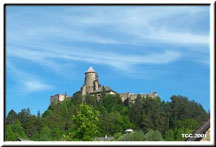
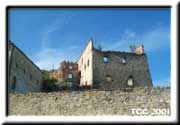
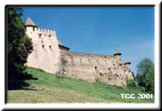
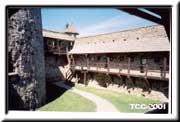
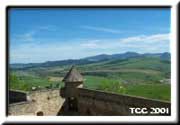
Chapel of St. Michael
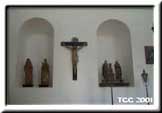
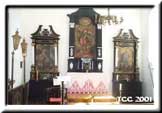
Armaments Room & Correspondence Room
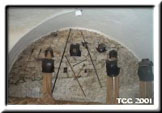
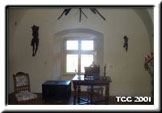
Dining Hall
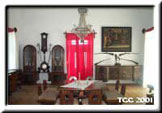
Photos Courtesy of Steven M. Osifchin
St. Michael the Archangel Greek Catholic Church
Built in 1833
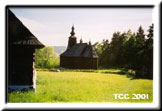
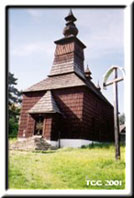
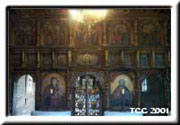
Each home interior represents the cycle of village life.
Birth is represented in the sixth photo and death is represented in the seventh.
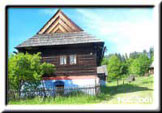
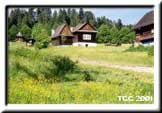
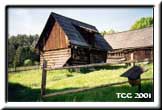
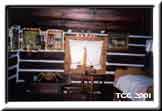
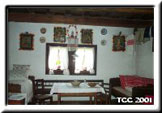
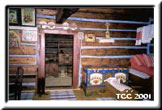
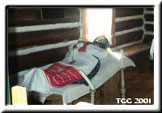
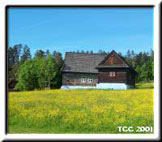
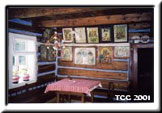
1948-2008
Eternal Memory - Vechnaya Pamyat


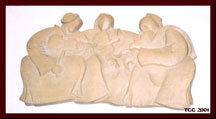

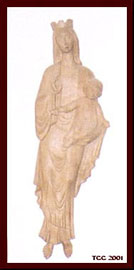

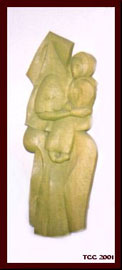
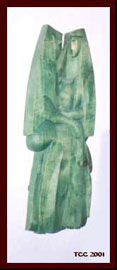
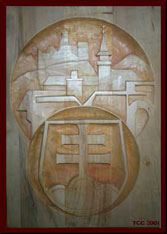
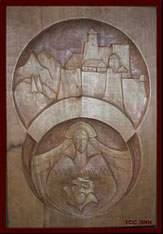
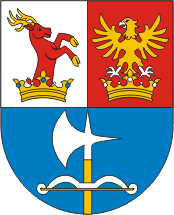
Photos Courtesy of Julia Ondrejcekova
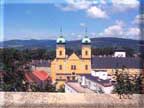 A lovely city close to the River Vah and nestled at the beginning of the Strazovske vrchy hills, Trencin is a must for any visitors itinerary. Approximately 70 miles from Bratislava in Western Slovakia, arriving in Trencin is very simple by bus or train service. If a visitor is utilizing a car, taking the E75 highway will bring you to Trencin where parking is rarely a problem in the town. Having a long and very interesting history, there are a number of places to visit.
A lovely city close to the River Vah and nestled at the beginning of the Strazovske vrchy hills, Trencin is a must for any visitors itinerary. Approximately 70 miles from Bratislava in Western Slovakia, arriving in Trencin is very simple by bus or train service. If a visitor is utilizing a car, taking the E75 highway will bring you to Trencin where parking is rarely a problem in the town. Having a long and very interesting history, there are a number of places to visit.
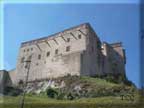 The city, which dates back to the Roman Empire period grew quickly and during 1412 became a royal free city. Construction began on Trencin Castle (which cannot be missed) in the 11th century. Unfortunately, the castle burned down during 1790 but thankfully has been reconstructed during time. An excellent vantage point to view this imposing edifice is from the town itself which is situated below the castle heights.
The city, which dates back to the Roman Empire period grew quickly and during 1412 became a royal free city. Construction began on Trencin Castle (which cannot be missed) in the 11th century. Unfortunately, the castle burned down during 1790 but thankfully has been reconstructed during time. An excellent vantage point to view this imposing edifice is from the town itself which is situated below the castle heights.
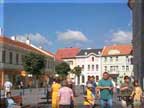 The main square in Trencin is Peace Square (Mierove namestie) and the houses and shops that line this square are architectural delights. Many of the houses were built in Renaissance style and they are exquisite to view. One very interesting site in the middle of Mierove namestie is a Baroque column. This column has a statue situated at the top and is called Holy Trinity Column. The history of this very impressive monument offers that it was commissioned by Duke Mikulas Ileshazy during 1712 to honor the memory of those who died during a plague epidemic in 1710. It is best to start a visit with the town square as many areas can be covered in a relatively short period of time. One of the more interesting places to visit near the square is the Trencin museum (Trencianske muzeum.) There are a number of exhibits offered here and the natural history section is interesting but has limited displays. Its always best to check what exhibits or displays will be presented as some can be very historical and educational.
The main square in Trencin is Peace Square (Mierove namestie) and the houses and shops that line this square are architectural delights. Many of the houses were built in Renaissance style and they are exquisite to view. One very interesting site in the middle of Mierove namestie is a Baroque column. This column has a statue situated at the top and is called Holy Trinity Column. The history of this very impressive monument offers that it was commissioned by Duke Mikulas Ileshazy during 1712 to honor the memory of those who died during a plague epidemic in 1710. It is best to start a visit with the town square as many areas can be covered in a relatively short period of time. One of the more interesting places to visit near the square is the Trencin museum (Trencianske muzeum.) There are a number of exhibits offered here and the natural history section is interesting but has limited displays. Its always best to check what exhibits or displays will be presented as some can be very historical and educational.
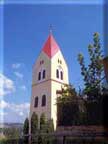 To the west of this square lies a gate tower. As you walk closer to the tower (it’s a creme based light color) there is a legend which explains if you talk while passing through it, you will never marry. After going though the tower there are restaurants and shops on each side of the narrow streets and these should be explored. For those who enjoy various architecture, the Baroque Piarist Church (Piaristicky kostol) is a visual delight. Also in the area near the Piarist church is a 19th century synagogue.
To the west of this square lies a gate tower. As you walk closer to the tower (it’s a creme based light color) there is a legend which explains if you talk while passing through it, you will never marry. After going though the tower there are restaurants and shops on each side of the narrow streets and these should be explored. For those who enjoy various architecture, the Baroque Piarist Church (Piaristicky kostol) is a visual delight. Also in the area near the Piarist church is a 19th century synagogue. 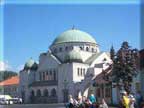 This synagogue, built in 1913, still utilizes one part as a place of worship but the other is an exhibition hall. Upon entering this beautiful house of worship the interior main dome makes a lasting impression. Walking further on, there is a very unique gallery offering the works of M.A. Bazovsky. The gallery is housed at a former Piarist monastery and the architecture combined with the gallery offer a very warm atmosphere for those who enjoy modern painting and sculpture. Some of Bazovsky’s paintings are very captivating including those of peasant life. Also on display are other works of talented Slovak painters, sculptors and artists from the Trencin region.
This synagogue, built in 1913, still utilizes one part as a place of worship but the other is an exhibition hall. Upon entering this beautiful house of worship the interior main dome makes a lasting impression. Walking further on, there is a very unique gallery offering the works of M.A. Bazovsky. The gallery is housed at a former Piarist monastery and the architecture combined with the gallery offer a very warm atmosphere for those who enjoy modern painting and sculpture. Some of Bazovsky’s paintings are very captivating including those of peasant life. Also on display are other works of talented Slovak painters, sculptors and artists from the Trencin region.
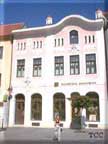 Being a city of over sixty-thousand, a visitor will find that even with this large number of residents there is a lack of congestion in places. There are many narrow lanes that wind their way through many streets and each has something to offer. There are a number of small sized parks and along many side streets a bench can always be found to sit and relax. Exploring the city from any point is always pleasant and can be very enriching. The best way to view Trencin and enjoy all it has to offer is definitely by walking. The pace here can be moderate but, only if you wish to join in. There are many side cafes and small areas where a visitor can sit and just enjoy the view. The atmosphere is very relaxing and on a warm day, sitting on a bench or at a cafe can be a very pleasurable experience. There are a number of outdoor cafes and in mild and warm weather these are excellent places to watch the rhythm of the town. One excellent benefit of Trencin is that it is a very quiet city and at times, not very busy. Depending upon the time of year visiting Trencin can not only be an excellent vacation destination but, also a very relaxing one as well.
Being a city of over sixty-thousand, a visitor will find that even with this large number of residents there is a lack of congestion in places. There are many narrow lanes that wind their way through many streets and each has something to offer. There are a number of small sized parks and along many side streets a bench can always be found to sit and relax. Exploring the city from any point is always pleasant and can be very enriching. The best way to view Trencin and enjoy all it has to offer is definitely by walking. The pace here can be moderate but, only if you wish to join in. There are many side cafes and small areas where a visitor can sit and just enjoy the view. The atmosphere is very relaxing and on a warm day, sitting on a bench or at a cafe can be a very pleasurable experience. There are a number of outdoor cafes and in mild and warm weather these are excellent places to watch the rhythm of the town. One excellent benefit of Trencin is that it is a very quiet city and at times, not very busy. Depending upon the time of year visiting Trencin can not only be an excellent vacation destination but, also a very relaxing one as well.
There are many shops, stores and all forms of places to explore. There are also various items to occupy any visitor including a ride on hot-air balloons and plane rides. The view during these rides of the area is breath-taking and also makes Trencin castle seem all the more magnificent. A visit to the castle itself is an excellent way to spend time. The walk up to the castle can be taxing but, the view from the castle of the town which lies below it is a photographers dream. Upon arrival at the castle area there is a fantastic view of the surrounding town and other areas in this region. Even on a very overcast day taking time to look at the area which surrounds the castle is time well spent. There is a moderate sized museum within the castle palace and in other areas exhibits are offered. There are sections of the castle that can be explored and these help to gain a better understanding of this fortress. The tour guides are very knowledgeable and you gain much more than the nominal entrance fee which includes a small booklet of history in Slovak and German. Its well worth taking these tours as they can offer a very historical and well grounded understanding of the castle.
For a visitor, there are a number of good restaurants and hotels. The Hotel Tatra is a very excellent hotel and, for those who enjoy history, has an inscription in the rear of the hotel telling of a Roman victory over various German tribes in the years 179 AD. Hotel Tatra offers an excellent restaurant, café and lovely wine cellar which offers light meals. This hotel is located in the center town and this makes it very popular. Two other hotels in the area are Sporthotel Zamarovce (this hotel offers hot-air balloon rides) and the Penzion Svorad which, while a more basic hotel, offers good accommodations at a very reasonable price. An interesting restaurant in Trencin is Restaurancia Inn 33 Club. The interior is smartly decorated with modern paintings and the atmosphere of this restaurant is inviting. Offering very good food, this restaurant is popular with tourists and local residents. The restaurant outdoor patio is always busy during warm weather and the Steps Pub is a very delightful gathering place which is located within an old cellar.
Also found all over town are numerous restaurants and "fast food" establishments. All forms of international foods along with local cuisine can be found within a short walking distance. Trencin enjoys a very mild climate and this is a major advantage for those who wish to do a great deal of sight seeing or outdoor activities such as hiking. There are many hiking and walking trails located in the lovely Povarsky Inovec region and these are not to be missed by those who cherish the outdoors. Since the Vah river is so close, other pleasures such as canoe rides and rafting are offered in this region. Many campsites, some with cabins, are available also near the Vah River and the accommodations are simple but for those who enjoy camping, its an excellent way to spend a few days.
Checking with the local tourist bureau can help determine what is available. A very good office to visit if you need information on the town is the Trencin Culture and Information office (Kulturno-informacne centrum mesta Trencin). This building is located at Sturovo namesti 10 and a wealth of information can be found including available hotels, restaurants, transportation, tickets for events and even artistic folk art souvenirs. Its best to check with this office as they will be able to inform a visitor of the dates of the many folk festivals, concerts and other information on entertainment. With this information known, it will help the visitor to make a visit to this lovely city in Western Slovakia a very exciting experience.



